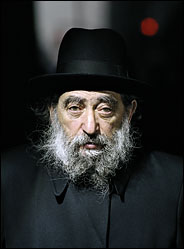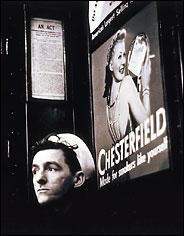| |
Published: March 19, 2006
IN
1999 Philip-Lorca diCorcia set up his camera on a tripod in Times
Square, attached strobe lights to scaffolding across the street
and, in the time-honored tradition of street photography, took
a random series of pictures of strangers passing under his lights.
The project continued for two years, culminating in an exhibition
of photographs called "Heads" at Pace/MacGill Gallery in Chelsea.
"Mr. diCorcia's pictures remind us, among other things, that we
are each our own little universe of secrets, and vulnerable,"
Michael Kimmelman wrote, reviewing the show in The New York Times.
"Good art makes you see the world differently, at least for a
while, and after seeing Mr. diCorcia's new 'Heads,' for the next
few hours you won't pass another person on the street in the same
absent way." But not everyone was impressed.

Pace/MacGill
Gallery, New York
The man in "Head No. 13, 2000," by Philip-Lorca diCorcia
is Erno Nussenzweig. When he saw his picture in an exhibition
catalog for diCorcia's "Heads," he sued the photographer
and his gallery.

Metropolitan
Museum of Art, Walker Evans Archive
Walker Evans took a series of pictures on the sly in the
subway in the 1940's; "Subway Passenger, New York City."
When
Erno Nussenzweig, an Orthodox Jew and retired diamond merchant
from Union City, N.J., saw his picture last year in the exhibition
catalog, he called his lawyer. And then he sued Mr. diCorcia
and Pace for exhibiting and publishing the portrait without
permission and profiting from it financially. The suit sought
an injunction to halt sales and publication of the photograph,
as well as $500,000 in compensatory damages and $1.5 million
in punitive damages.
The
suit was dismissed last month by a New York State Supreme
Court judge who said that the photographer's right to artistic
expression trumped the subject's privacy rights. But to many
artists, the fact that the case went so far is significant.
The
practice of street photography has a long tradition in the
United States, with documentary and artistic strains, in big
cities and small towns. Photographers usually must obtain
permission to photograph on private property — including
restaurants and hotel lobbies — but the freedom to photograph
in public has long been taken for granted. And it has had
a profound impact on the history of the medium. Without it,
Lee Friedlander would not have roamed the streets of New York
photographing strangers, and Walker Evans would never have
produced his series of subway portraits in the 1940's.
Remarkably,
this was the first case to directly challenge that right.
Had it succeeded, "Subway Passenger, New York City," 1941,
along with a vast number of other famous images taken on the
sly, might no longer be able to be published or sold.
In
his lawsuit, Mr. Nussenzweig argued that use of the photograph
interfered with his constitutional right to practice his religion,
which prohibits the use of graven images.
New
York state right-to-privacy laws prohibit the unauthorized
use of a person's likeness for commercial purposes, that is,
for advertising or purposes of trade. But they do not apply
if the likeness is considered art. So Mr. diCorcia's lawyer,
Lawrence Barth, of Munger, Tolles & Olson in Los Angeles,
focused on the context in which the photograph appeared. "What
was at issue in this case was a type of use that hadn't been
tested against First Amendment principles before — exhibition
in a gallery; sale of limited edition prints; and publication
in an artist's monograph," he said in an e-mail message. "We
tried to sensitize the court to the broad sweep of important
and now famous expression that would be chilled over the past
century under the rule urged by Nussenzweig." Among others,
he mentioned Alfred Eisenstaedt's famous image of a sailor
kissing a nurse in Times Square on V-J Day in 1945, when Allied
forces announced the surrender of Japan.
Several previous cases were also cited in Mr. diCorcia's defense.
In Hoepker v. Kruger (2002), a woman who had been photographed
by Thomas Hoepker, a German photographer, sued Barbara Kruger
for using the picture in a piece called "It's a Small World
... Unless You Have to Clean It." A New York federal court
judge ruled in Ms. Kruger's favor, holding that, under state
law and the First Amendment, the woman's image was not used
for purposes of trade, but rather in a work of art.
Also
cited was a 1982 ruling in which the New York Court of Appeals
sided with The New York Times in a suit brought by Clarence
Arrington, whose photograph, taken without his knowledge while
he was walking in the Wall Street area, appeared on the cover
of The New York Times Magazine in 1978 to illustrate an article
titled "The Black Middle Class: Making It." Mr. Arrington
said the picture was published without his consent to represent
a story he didn't agree with. The New York Court of Appeals
held that The Times's First Amendment rights trumped Mr. Arrington's
privacy rights.
In
an affidavit submitted to the court on Mr. diCorcia's behalf,
Peter Galassi, chief curator of photography at the Museum
of Modern Art, said Mr. diCorcia's "Heads" fit into a tradition
of street photography well defined by artists ranging from
Alfred Stieglitz and Henri Cartier-Bresson to Robert Frank
and Garry Winogrand. "If the law were to forbid artists to
exhibit and sell photographs made in public places without
the consent of all who might appear in those photographs,"
Mr. Galassi wrote, "then artistic expression in the field
of photography would suffer drastically. If such a ban were
projected retroactively, it would rob the public of one of
the most valuable traditions of our cultural inheritance."
Neale
M. Albert, of Paul, Weiss, Rifkind, Wharton & Garrison,
who represented Pace/MacGill, said the case surprised
him: "I have always believed that the so-called street
photographers do not need releases for art purposes. In
over 30 years of representing photographers, this is the
first time a person has raised a complaint against one
of my clients by reason of such a photograph."
State
Supreme Court Justice Judith J. Gische rejected Mr. Nussenzweig's
claim that his privacy had been violated, ruling on First
Amendment grounds that the possibility of such a photograph
is simply the price every person must be prepared to pay
for a society in which information and opinion freely
flow. And she wrote in her decision that the photograph
was indeed a work of art. "Defendant diCorcia has demonstrated
his general reputation as a photographic artist in the
international artistic community," she wrote.
But
she indirectly suggested that other cases might be more
challenging. "Even while recognizing art as exempted from
the reach of New York's privacy laws, the problem of sorting
out what may or may not legally be art remains a difficult
one," she wrote. As for the religious claims, she said:
"Clearly, plaintiff finds the use of the photograph bearing
his likeness deeply and spiritually offensive. While sensitive
to plaintiff's distress, it is not redressable in the
courts of civil law."
Mr.
diCorcia, whose book of photographs "Storybook Life" was
published in 2004, said that in setting up his camera
in Times Square in 1999: "I never really questioned the
legality of what I was doing. I had been told by numerous
editors I had worked for that it was legal. There is no
way the images could have been made with the knowledge
and cooperation of the subjects. The mutual exclusivity
that conflict or tension, is part of what gives the work
whatever quality it has."
Mr.
Nussenzweig is appealing. Last month his lawyer Jay Goldberg
told The New York Law Journal that his client "has lost
control over his own image."
"It's
a terrible invasion to me," Mr. Goldberg said. "The last
thing a person has is his own dignity."
Photography
professionals are watching — and claiming equally
high moral stakes. Should the case proceed, said Howard
Greenber
|
|
 Metropolitan Museum of Art, Walker Evans Archive
Metropolitan Museum of Art, Walker Evans Archive